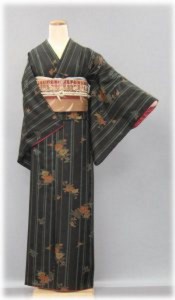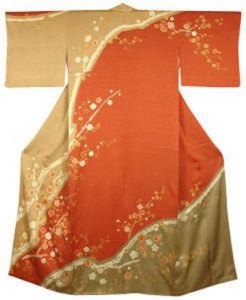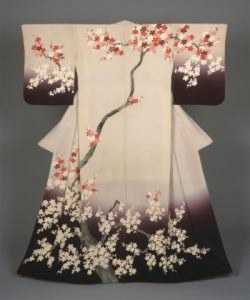日本の服の歴史
Clothing (ifuku) in Japan is divided into two types: wafuku (clothing in Japanese style) and yofuku (clothing in the Western style). Nowadays “kimono” is called the type of dressing gown, which is fastened on the body with a belt. However, in the centuries past this type of clothing was called “kosode” (kimono can also mean the Japanese clothing in general).
The history of Japanese traditional clothing is somehow the history of the development of kosode. In the result of the penetration of Buddhism and the system of Chinese government into Japan, there were adopted rules on the clothing of aristocrats and royal officials. The clothing was classified into ritual, royal and working.

In the Heian era (782—806) the clothing were plain, but multi-layer. The clothing of the aristocrats during official ceremonies consisted of wide trousers, under which there were the so called parted skirts. The top was decorated with long and wide clothing. On less formal occasions men wore sasinuki (lace-up long trousers) as trousers. Women’s clothing in the Heian era was karaginumo (since the 16th century it is known as 12-layer clothing). Its most important element was utsiki –a dress with 5, 10 or with more layers. Moreover, each next layer was longer the previous one and color combination was also taken into consideration. As an everyday clothing women wore the simplified type of utsiki. On trains they wore straw laced hats or kerchiefs without lining. Not highborn women wore more ordinary clothes, for example short dresses without sleeves.

In the Kamakura era (1185-1333), which was marked with the declination of the reputation of the empire court, the elegant silk dress yielded its place to the strict military clothing. As an everyday clothing they wore wide collar hitatare, the tips of which were put into the trousers. During this era women preferred utsiki or hakama (trousers or skirts), but in the future ustiki was replaced by kosode – a short-sleeve dress.
In the Muromachi era (1336-1573) only jackets were added, which were worn above kosode.
In the Azuchi-Momoyama era (1568/1573-1600/1603), under the influence of military-political leaders Oda Nobunaga and Toyotomi Hideyoshi, who preached bright, decorative style, as well as in the result of strengthening ties with the West and China, the clothing of the aristocrats were more enriched.
In the Edo era (1603-1868) the kosodes of women and men were more enriched, which was conditioned by the mastering of new technologies of fabric painting. The state regulated the types, colors and fabrics of clothing for common people and soldiery. The military started to wear kosode.
After the restoration of Meiji (1868-1889) the slow pace of the Westernization of Japanese clothing started, moreover men’s clothing was of primary importance. Only after the Second World War wearing Western clothing became an ordinary phenomenon for all the layers of the society.
Nowadays the Japanese clothing is a mixture of various styles and directions. From the pedantry of classical European suits and Japanese traditional kimonos to wild eclectics – you can see everything in the megapolises of Japan. The Japanese are among the few, who preserve their traditions, but are not afraid of innovations.
https://nipponnitsuite.wordpress.com/2015/03/05/kimono_history/から取られた材料
translated from Armenian into English by M.Vardanyan












